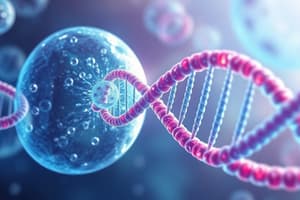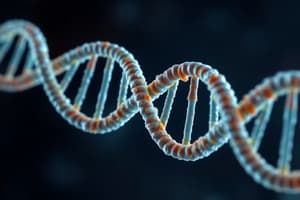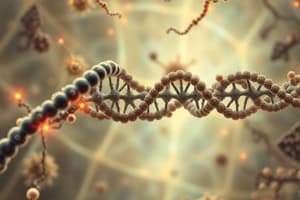Podcast
Questions and Answers
What does DNA stand for?
What does DNA stand for?
- Deoxyribonuclear Acid
- Double Helix Acid
- Deoxyribonucleic Acid (correct)
- Ribonucleic Acid
What is a gene?
What is a gene?
A unit of heredity transferred from parent to offspring.
What is the main function of the nucleus?
What is the main function of the nucleus?
It is the central part of a cell that controls activities.
What is the structure of DNA known as?
What is the structure of DNA known as?
What sugar is found in DNA?
What sugar is found in DNA?
What are nitrogen bases?
What are nitrogen bases?
What type of bond holds the DNA strands together?
What type of bond holds the DNA strands together?
What does replication refer to in biology?
What does replication refer to in biology?
What does Chargaff's Rule state?
What does Chargaff's Rule state?
What is the significance of the term 'antiparallel' in DNA?
What is the significance of the term 'antiparallel' in DNA?
What is a nucleotide?
What is a nucleotide?
What is interphase?
What is interphase?
What is the role of DNA helicase?
What is the role of DNA helicase?
What role does DNA polymerase play?
What role does DNA polymerase play?
What is cell division?
What is cell division?
What is transcription?
What is transcription?
What happens during translation?
What happens during translation?
What is a codon?
What is a codon?
What is an anticodon?
What is an anticodon?
What is tRNA?
What is tRNA?
What is mRNA?
What is mRNA?
What is RNA polymerase?
What is RNA polymerase?
What is a ribosome?
What is a ribosome?
What does the Golgi apparatus do?
What does the Golgi apparatus do?
What is the endoplasmic reticulum?
What is the endoplasmic reticulum?
What is a start codon?
What is a start codon?
What is a stop codon?
What is a stop codon?
What are mutations?
What are mutations?
What are substitution mutations?
What are substitution mutations?
What are insertion mutations?
What are insertion mutations?
What is a frameshift mutation?
What is a frameshift mutation?
Flashcards are hidden until you start studying
Study Notes
DNA and Genetic Information
- DNA is a self-replicating molecule found in all living organisms, key to genetic information.
- Genes are units of heredity that determine traits passed from parents to offspring.
- The structure of DNA is a double helix, comprising two intertwined helices.
Molecular Components and Processes
- Nucleotides are the basic units of nucleic acids, composed of a nucleoside and a phosphate group.
- Deoxyribose is the sugar component of DNA, modified from ribose.
- Nitrogen bases are critical for DNA and RNA structure, including adenine, guanine, cytosine, thymine, and uracil.
Key Biological Processes
- Replication is the process of copying DNA before cell division.
- Transcription is the first step in gene expression, where DNA is copied to RNA by RNA polymerase.
- Translation involves ribosomes converting mRNA into proteins, following the genetic instructions.
Structure and Function
- Hydrogen bonds connect nitrogen bases, maintaining DNA's double helix structure.
- The nucleus houses DNA and is vital for cellular functions and growth.
- Ribosomes are responsible for polypeptide synthesis, linking amino acids as dictated by mRNA.
Cell Division and Genetic Variability
- Cell division results in two daughter cells with identical genetic material.
- Interphase is the phase of preparation for cell division between mitotic cycles.
- Mutations, including substitutions, insertions, and frameshift mutations, contribute to genetic diversity and evolution.
Codons and Translation Mechanism
- Codons consist of three nucleotides, coding for specific amino acids in protein synthesis.
- Anticodons in tRNA match codons in mRNA, ensuring correct protein assembly.
- The start codon (AUG) signals the beginning of translation, while stop codons (UAG, UAA, UGA) terminate protein synthesis.
Cellular Organelles
- The Golgi apparatus processes and transports proteins and lipids within cells.
- The endoplasmic reticulum is a network of membranes involved in lipid and protein synthesis, usually ribosome-studded.
Chargaff's Rule
- Chargaff's rule establishes that DNA must maintain a 1:1 ratio of purines (adenine and guanine) to pyrimidines (cytosine and thymine).
Antiparallel Structure
- DNA strands run in opposite directions (antiparallel), which is essential for replication and transcription fidelity.
Studying That Suits You
Use AI to generate personalized quizzes and flashcards to suit your learning preferences.




